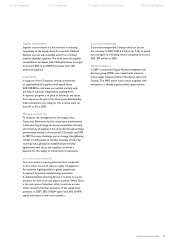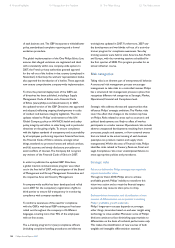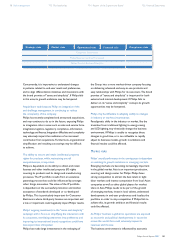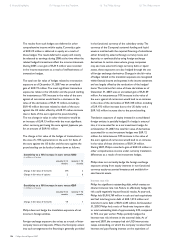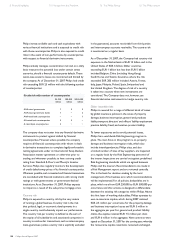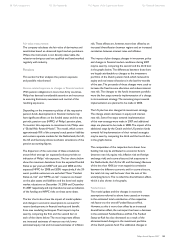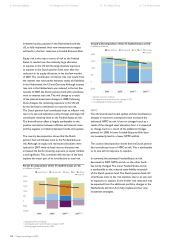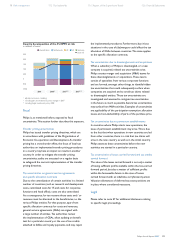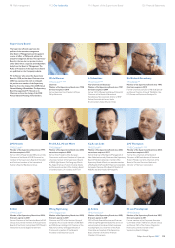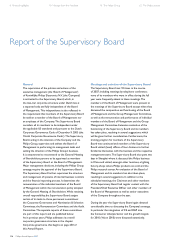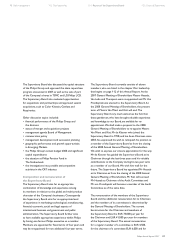Philips 2007 Annual Report Download - page 101
Download and view the complete annual report
Please find page 101 of the 2007 Philips annual report below. You can navigate through the pages in the report by either clicking on the pages listed below, or by using the keyword search tool below to find specific information within the annual report.
Philips Annual Report 2007 107
EUR 347 million. Fair value hedge accounting is applied
to these interest rate swaps. Including the effect of the
interest rate swaps the ratio of xed long-term debt to
total outstanding debt as at December 31, 2007, is 24%,
compared to 64% one year earlier. Total short-term debt
includes three bonds for a total book value of EUR 1,692
million of which EUR 130 million is due to mature in
February 2008, while the remaining balance of EUR 1,562
million matures in May 2008.
Certain past interest rate hedges related to bonds
were unwound during 2004. The fair value adjustments
to the bonds are amortized to the income statement
based on the recalculated effective yield. In 2007, a gain
of EUR 5 million was released to the income statement.
As of December 31, 2007, the majority of debt consisted
of bonds.
A sensitivity analysis shows that if long-term interest rates
were to decrease instantaneously by 1% from their level
of December 31, 2007, with all other variables (including
foreign exchange rates) held constant, the fair value of the
long-term debt would increase by approximately EUR 63
million. This change would be partially offset by the change
in fair value of the interest rate swaps, which would increase
by EUR 38 million. If there was an increase of 1% in long-
term interest rates, this would reduce the market value
of the long-term debt by approximately EUR 63 million.
This change would be partially offset by the change in fair
value of the interest rate swaps, which would decrease by
EUR 33 million.
If interest rates were to increase instantaneously by 1%
from their level of December 31, 2007, with all other
variables held constant, the annualized net interest
expense would decrease by approximately EUR 54
million due to Philips signicant cash position. This
impact is based on the outstanding net cash position
at December 31, 2007.
Liquidity risk
The rating of the Company’s debt by major rating services
may improve or deteriorate. As a result, Philips’ borrowing
capacity may be inuenced and its nancing costs may
uctuate. Philips has various sources to mitigate the
liquidity risk for the group, including EUR 8,769 million
in cash and cash equivalents, a USD 2,500 million
Commercial Paper Program, and a USD 2,500 million
committed revolving facility that could serve as back-up
for short-term nancing requirements that would
normally be satised through the Commercial Paper
Program and EUR 4,464 million of investments in its
main available-for-sale securities and listed equity-
accounted investees at market value at December 31,
2007. The Company has a lock-up period associated
with the sale of shares in TPV Technology that expires in
September 2008 and a further lock up period associated
with the sale of shares in LG.Philips LCD that expired in
January 2008.
Equity price risk
Philips is a shareholder in several publicly listed companies
including TSMC, LG.Philips LCD and TPV Technology
Ltd. As a result, Philips is exposed to potential nancial
loss through movements in the share prices. The aggregate
equity price exposure of publicly listed investments in
its main available-for-sale securities, trading securities and
listed equity-accounted investees amounted to approximately
EUR 4,464 million at year end 2007 (2006: EUR 9,524
million including shares that were sold during 2007).
Philips also holds options on the shares of TPV through
a convertible bond issued to Philips in September 2005,
the face value of the bond being the USD equivalent of
EUR 143 million and the fair value of the option at year-
end
EUR 47 million. Philips does not hold derivatives in
its own stock or in the above-mentioned listed companies
except for the embedded derivatives in the convertible
bond already mentioned.
Commodity price risk
Philips is a purchaser of certain base metals, precious
metals and energy. Philips hedges certain commodity
price risks using derivative instruments to minimize
signicant, unanticipated earnings uctuations caused
by commodity price volatility. The commodity price
derivatives that Philips enters into are concluded as
cash ow hedges to offset forecasted purchases.
Currently, a loss of EUR 1 million is deferred in equity
as a result of these hedges. A 10% increase in the market
price of all commodities as at December 31, 2007, would
increase the fair value of the derivatives by EUR 4 million.
Credit risk
Credit risk represents the loss that would be recognized
at the reporting date if counterparties failed completely to
perform their payment obligations as contracted. Credit
risk is present within Philips trade receivables. To reduce
exposure to credit risk, Philips performs ongoing evaluations
of the nancial condition of its customers and adjusts
payment terms and credit limits when appropriate.
98 Risk management 112 Our leadership 116 Report of the Supervisory Board 126 Financial Statements


